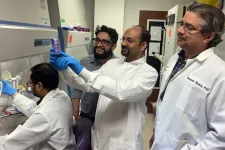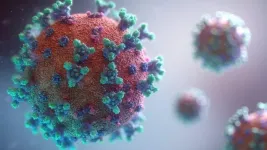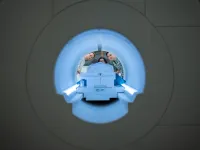(Press-News.org) Politicians who are the parents of daughters provide researchers with a “natural experiment” to test how personal circumstances influence legislators’ roll call votes. Research published in 2008, by author Ebonya Washington, showed that members of the U.S. House of Representatives with daughters cast more liberal votes on women’s issues during the period between 1997 and 2005. But another study published in 2019 by researchers Mia Costa et al., covering the period between 2007 and 2017, did not find such an effect.
In their new paper “Revisiting a Natural Experiment: Do Legislators With Daughters Vote More Liberally on Women’s Issues?” published in the Journal of Political Economy Microeconomics, Donald P. Green, Oliver Hyman-Metzger, Gaurav Sood, and Michelle A. Zee set out to investigate this question further with additional data. Using a larger dataset than those analyzed in the previous studies, they find that having daughters has no effect on how legislators vote on women’s issues.
The authors start their analysis in 1981, prior to the analysis presented in the 2008 paper by Washington, and in a time when, they posit, political polarization was “relatively tame by contemporary standards.” They end their analysis after the presentation of the 2019 paper by Costa et al. Subsequently, the researchers determine the gender proportions of the children of the lawmakers serving in these 20 total congresses, via archives and congressional offices.
From the voting record, Green, Hyman-Metzger, Sood, and Zee determined which roll call votes during each Congress concerned women’s issues, and coded each legislator’s voting record according to whether it was pro-feminist. They also tracked specific legislators’ votes over time, in order to study if the specific roll call votes held in certain Congresses influenced the results of the previous work.
The authors find that, across sessions of Congress, having daughters has little effect on how members voted on women’s issues. This finding holds over time. “If party polarization dampens the daughters effect, going backward in time should increase the apparent average treatment effect,” the authors say. “This prediction is not borne out,” they write – the rise of polarization does not change this pattern.
The researchers note that they successfully replicated the results obtained in the 2008 paper by Washington and the 2019 paper by Costa et al. “The only era during which the daughters effect is positive is the one that Washington happened to study,” they say. “The daughters effect found by Washington is a thought-provoking empirical result that seems to demonstrate that roll call votes are influenced by legislators’ personal circumstances and experiences,” the authors write, while the lack of such an effect reported by Costa et al. indicate that perhaps partisanship has taken precedence over family influences as political polarization has increased. “The findings presented here seem to support a more mundane interpretation,” the authors conclude: “daughters do not seem to have any appreciable effect on legislators’ roll call votes.”
END
Having daughters might not move politicians’ votes on women’s issues to the left, after all
2023-05-01
ELSE PRESS RELEASES FROM THIS DATE:
Lee studying how to improve access to disability service information in Virginia
2023-05-01
Myeong Lee, Assistant Professor, Information Sciences and Technology, is leading a study to help people with disabilities and their families in Virginia access information about disability services more easily.
The 2022 Information Access Assessment report by the Virginia Board for People with Disabilities (VBPD) revealed that many people with disabilities and their families struggle to find the necessary information about disability services, even when they actively seek help from service agencies. ...
Herpes study adds to understanding of viral reinfections, how to potentially prevent them
2023-05-01
A new study on herpes infections of the eye from University of Illinois Chicago researchers helps shed light on the question of viral reinfections by identifying a key protein involved in viral reinfections that could be targeted by antiviral drugs.
The UIC team examined how the heparanase protein, which is present in all our cells, affects reinfection from the herpes simplex virus type 1 in mice. They found that inhibiting heparanase activity can protect the eyes from being reinfected. Mice that had their heparanase protein blocked ...
WVU announces drill date for first geothermal, carbon capture and storage data-collection well in West Virginia
2023-05-01
Drilling will start on the West Virginia University geothermal and carbon capture data-collection well during the second week of May, marking a significant step forward in clean energy research in West Virginia.
This will be the first-of-its-kind geothermal study in West Virginia and will collect core samples and temperature data down to a depth of 15,000 feet, critical to testing the potential of geothermal energy in the region. Data also will be gathered on the potential for underground carbon storage in the Appalachian basin — another scientific first in the state.
The project is ...
Occludin protein plays key role in spread of coronavirus throughout body’s cells
2023-05-01
COLUMBIA, Mo. -- While the coronavirus continues to infect people around the world, researchers at the University of Missouri have identified a specific protein inside the human body that plays a critical role in how the virus spreads from cell to cell after infection — a discovery that will help better understand the COVID-19 disease and could lead to the development of new antiviral drugs in the future.
The finding provides new insight into how the protein, known as the occludin protein, serves as a mediator for cell-to-cell transmission ...
In-person Poster Hall and Traditional Meeting Length Returning for ACR Convergence 2023
2023-05-01
ATLANTA – ACR Convergence 2023, the annual meeting of the American College of Rheumatology (ACR) and the world’s premier rheumatology experience, will be held Nov. 10 – 15 at the San Diego Convention Center in San Diego, CA. This year’s meeting includes the return of an in-person poster hall, five in-person networking lounges, CME for select plenary sessions, and an extra half day of scientific sessions.
“We are looking forward to a great meeting this fall in beautiful San Diego! This year, we will showcase a greater number and diversity of sessions with our return to the original meeting length,” ...
World's first realistic simulated driving environment based on 'crash-prone' Michigan intersection
2023-05-01
Photos
The first statistically realistic roadway simulation has been developed by researchers at the University of Michigan. While it currently represents a particularly perilous roundabout, future work will expand it to include other driving situations for testing autonomous vehicle software.
The simulation is a machine-learning model that trained on data collected at a roundabout on the south side of Ann Arbor, recognized as one of the most crash-prone intersections in the state of Michigan and conveniently just a few miles from the offices of the research team.
Known as the Neural Naturalistic Driving Environment or NeuralNDE, it turned that data into a simulation ...
Changes in depression, anxiety among children and adolescents from before to during pandemic
2023-05-01
About The Study: This systematic review and meta-analysis of 53 longitudinal studies including more than 40,000 children and adolescents across 12 countries found an increase in depression symptoms during the COVID-19 pandemic, particularly among female individuals and those from relatively higher-income backgrounds. Anxiety symptoms increased slightly during the pandemic. These findings can inform policy and public health responses to address mental health concerns.
Authors: Sheri Madigan, Ph.D., of the University of Calgary in Calgary, Canada, is the ...
Physical activity trajectories and functional recovery after stroke
2023-05-01
About The Study: The results of this study of 1,300 participants suggest that increased physical activity was associated with functional recovery 6 months after stroke. Interventions targeting individuals with decreasing physical activity in the subacute phase of stroke may play a role in improved functional outcomes.
Authors: Dongni Buvarp, M.D., Ph.D., of the University of Gothenburg in Gothenburg, Sweden, is the corresponding author.
To access the embargoed study: Visit our For The Media website at this link https://media.jamanetwork.com/
(doi:10.1001/jamanetworkopen.2023.10919)
Editor’s ...
Brain activity decoder can reveal stories in people’s minds
2023-05-01
A new artificial intelligence system called a semantic decoder can translate a person’s brain activity — while listening to a story or silently imagining telling a story — into a continuous stream of text. The system developed by researchers at The University of Texas at Austin might help people who are mentally conscious yet unable to physically speak, such as those debilitated by strokes, to communicate intelligibly again.
The study, published in the journal Nature Neuroscience, was led by Jerry Tang, a doctoral student in computer science, and Alex Huth, an assistant professor of neuroscience and computer science at UT Austin. The work relies in part on a transformer ...
More than a decade after the theory of interdependent networks was introduced, researchers establish the first physics laboratory benchmark for its manifestation
2023-05-01
In 2010 Prof. Shlomo Havlin and collaborators published an article in the journal Nature proposing that the abrupt electricity failure causing the famous 2003 Italy blackout was a consequence of the inter-dependency of two networks. According to Havlin's theory the dependency between the power network and its communication system led to cascading failures and abrupt collapse. Havlin's seminal work ignited a new field in statistical physics known as “network of networks” or "interdependent networks" and paved the way for understanding and predicting the effects of the ...




